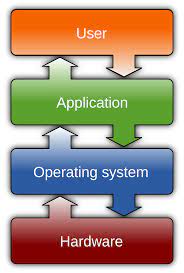 # Outline:
# Outline:
- Examples
- Basic Concepts
- Scheduling Criteria
- Scheduling Algorithms
- Multiple-Processor Scheduling
- Thread Scheduling
- Linux Scheduling
- Algorithm Evaluation
1.Examples
2.Basic Concepts:
Alternating Sequence of CPU and I/O bursts:
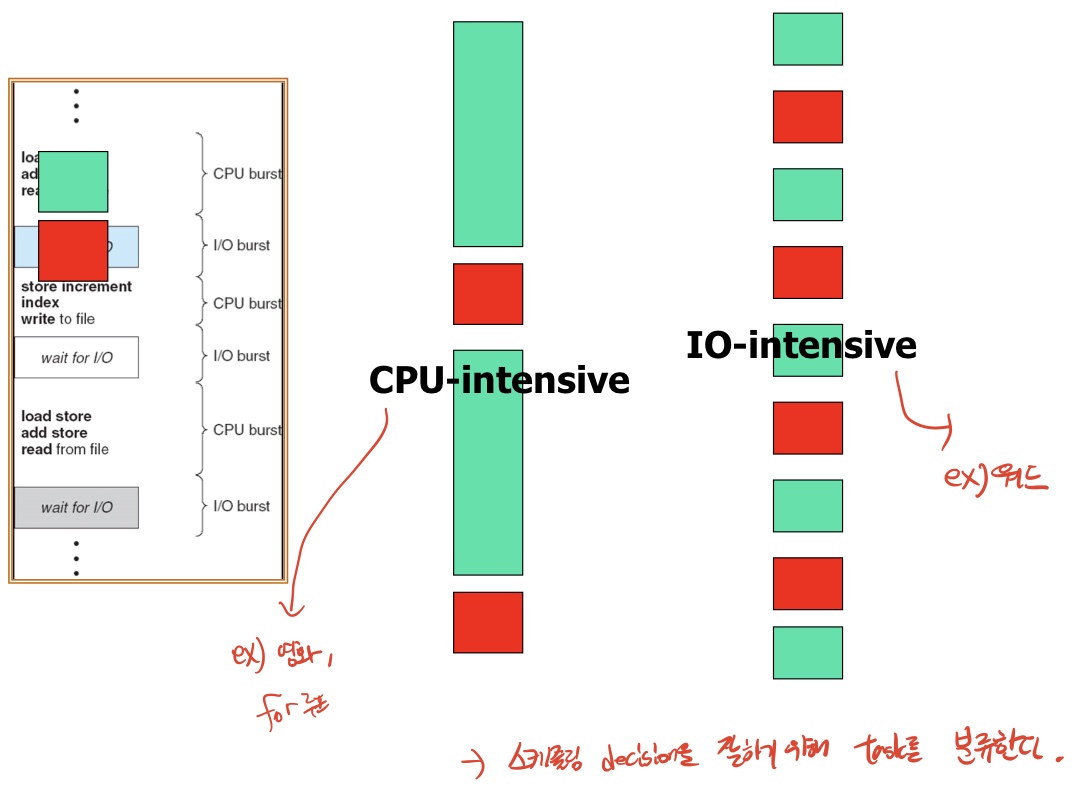
General rule of Scheduling:
give higher priorities to I/O bound processes thatn CPU-bound processes -> waiting-time을 최소하는데 효과적이다.
CPU scheduler:
selects from the processes in memory thar are ready to execute, and dispatcher allocates the CPU to one of them
CPU scheduler decision may take place when a process:
- Switches from running to waiting state
- Terminates (from running to termination)
- Switches from running to ready state.
- Switches from waiting to ready state. (ready로 전환된 프로세스의 우선순위가 현재 실행중인 프로세스의 우선순위보다 높을수있기때문에)
-> 1,2 : non-preemptive scheduling.
-> 3,4 : preemptive scheduling.
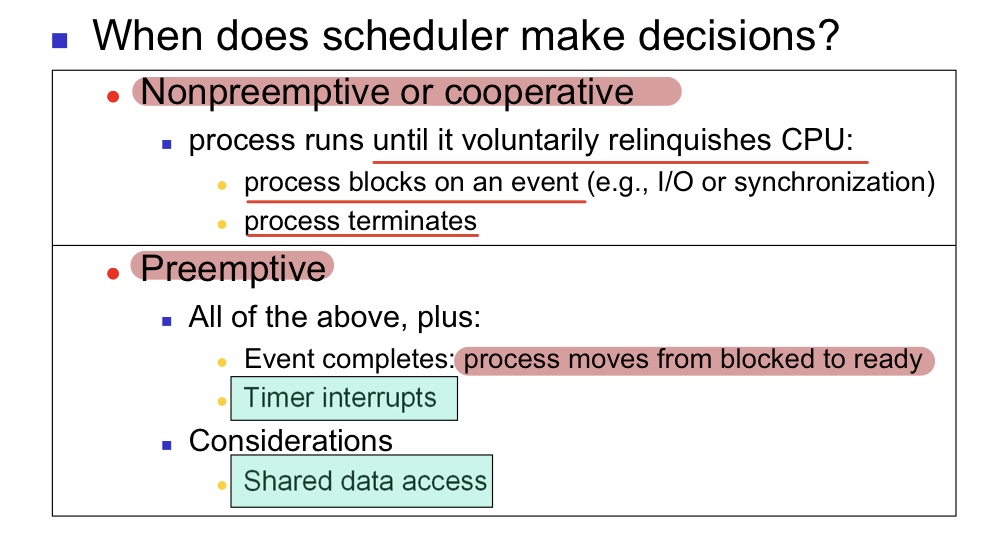
Preemption in the kernel
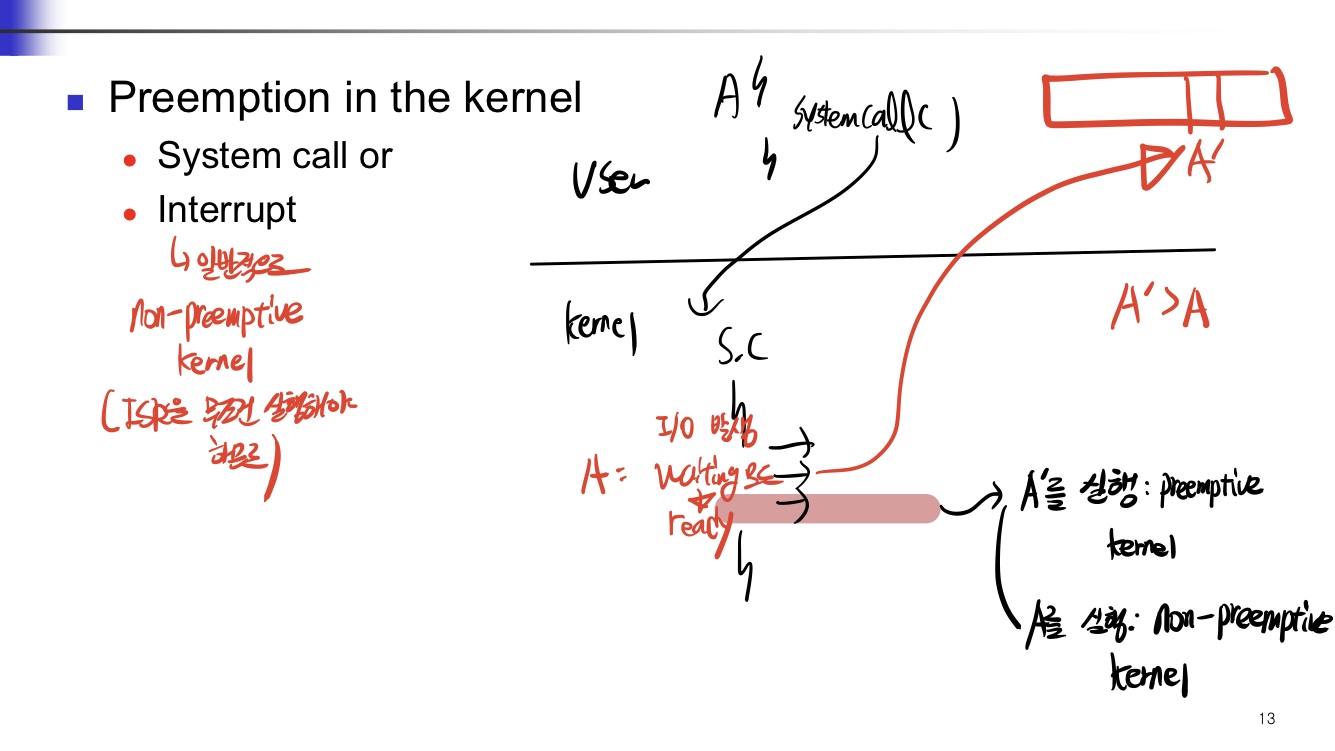
3.Scheduling Criteria:
-
cpu utilization:
- keep the cpu as busy as possible
-
throughout
- #of processes that complete their execution per time unit
-> 1,2 is applied to the entire system
-
turnaround time
- completion of process
-
waiting time
- amount of time a process has been waiting in the ready queue
-
response time
- amount of time it takes from when a request was submitted until the first response is produced.
-> 3,4,5 from the point of view of a particular process
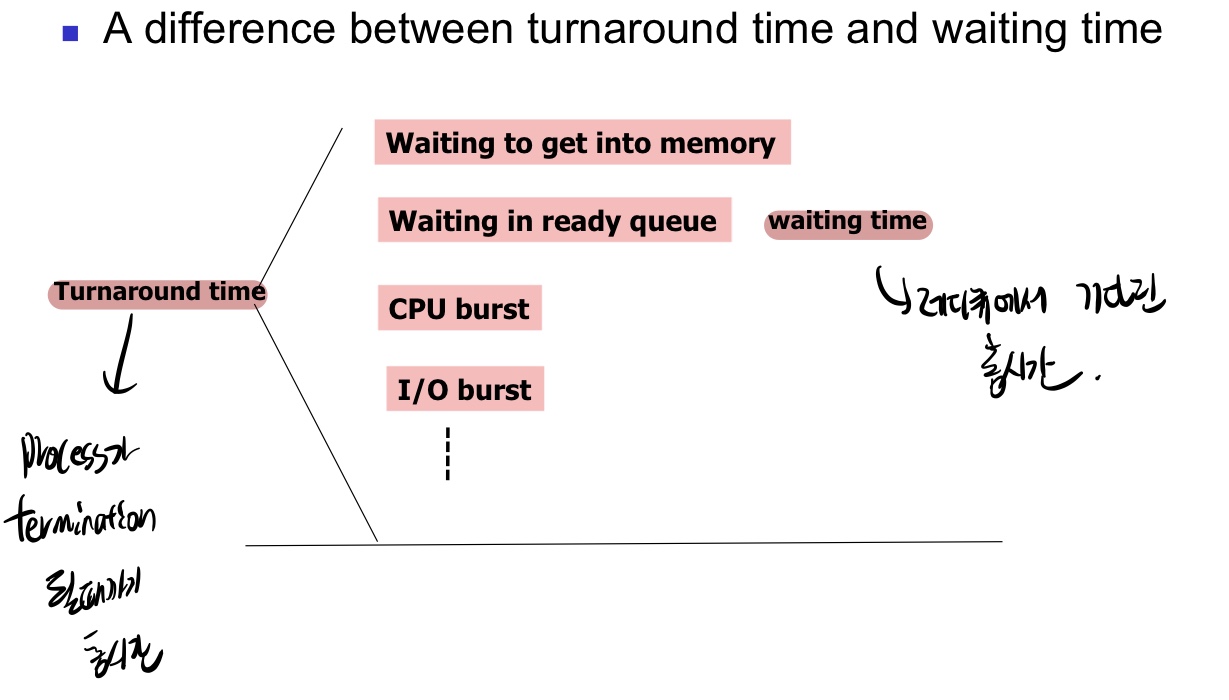
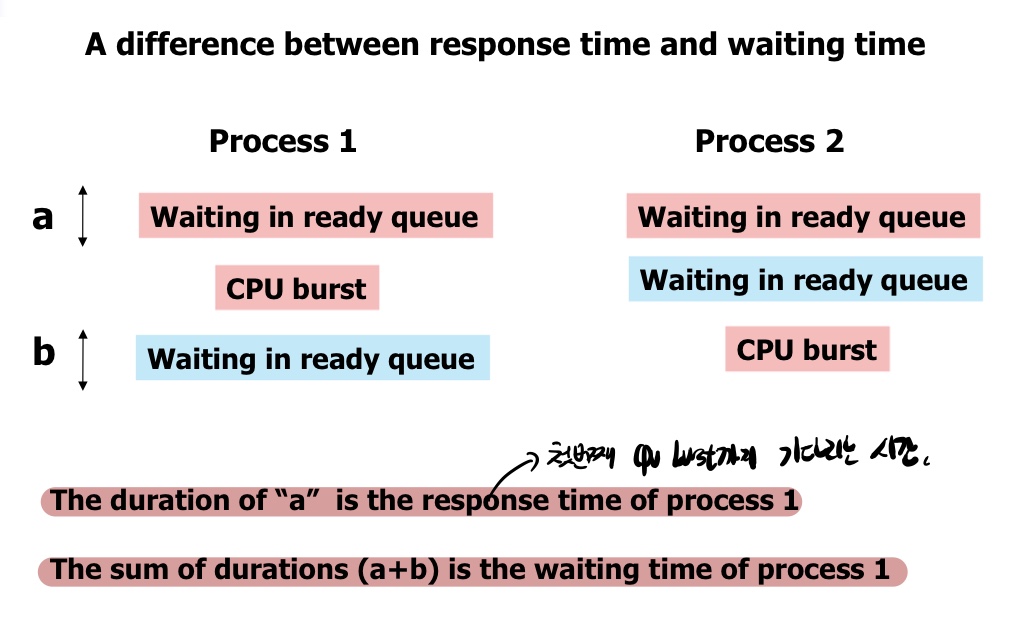
4.Scheduling Algorithms
1. First-come,Fisrt-served(FCFS) scheduling:
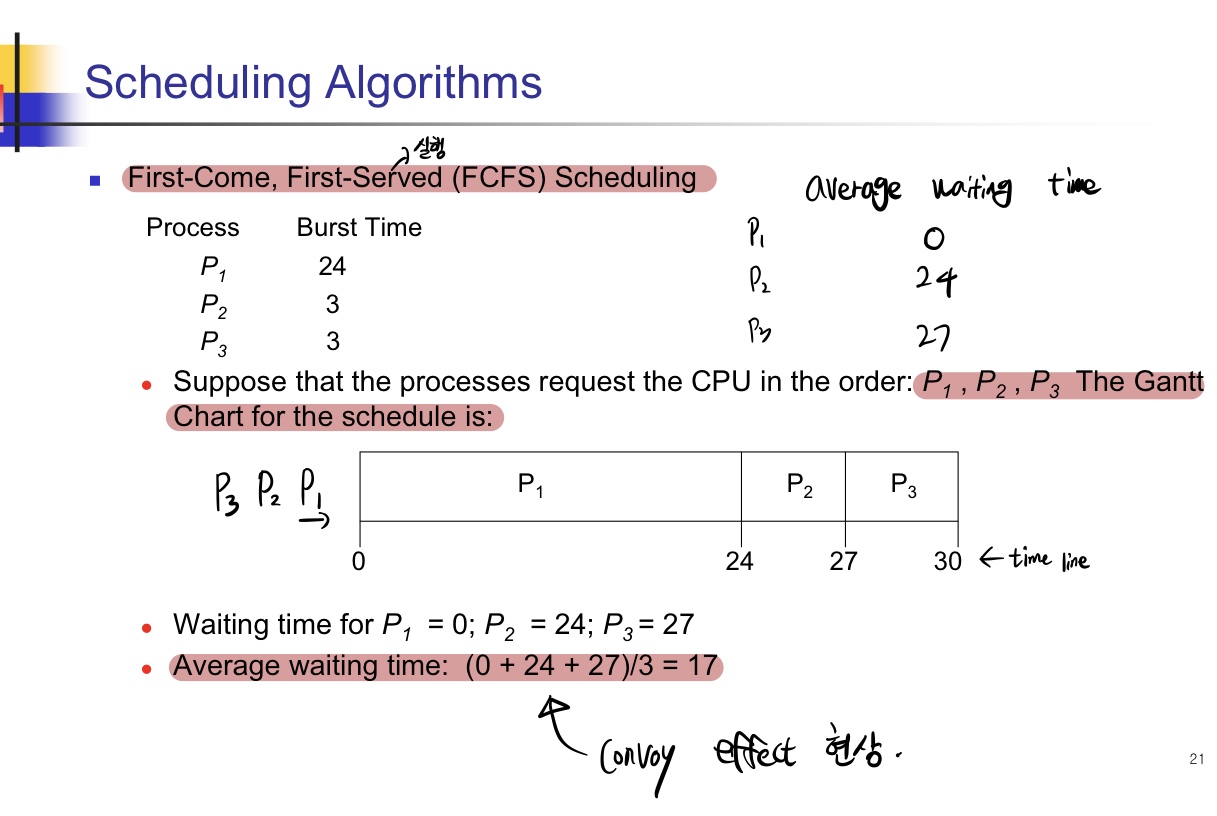
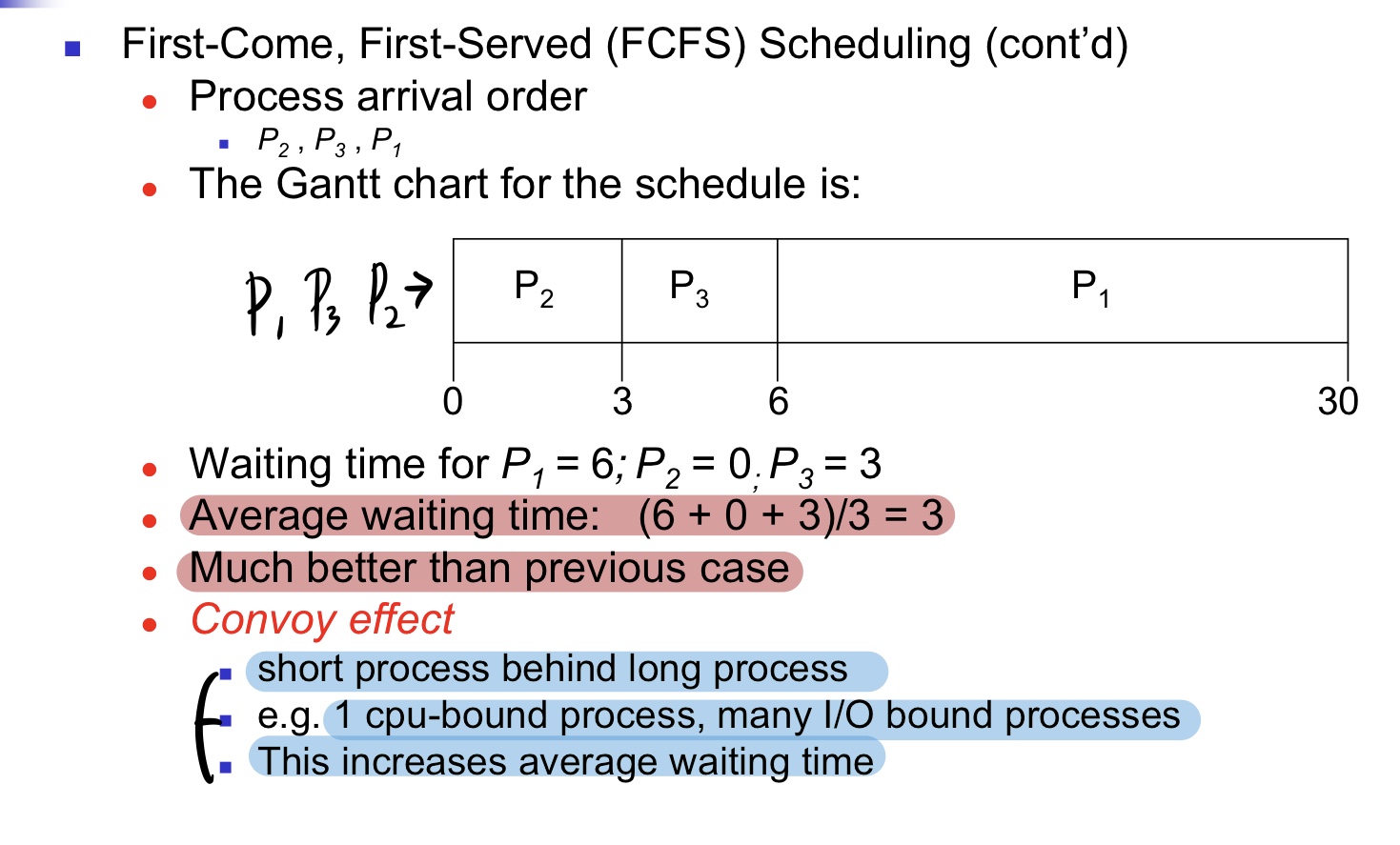
- Convoy effect: cpu burst length가 짧은 process가 긴 process 뒤에 스케쥴링되면 average waiting time을 증가시킨다.
2. Shortest-Job-First (SJF) Scheduling:
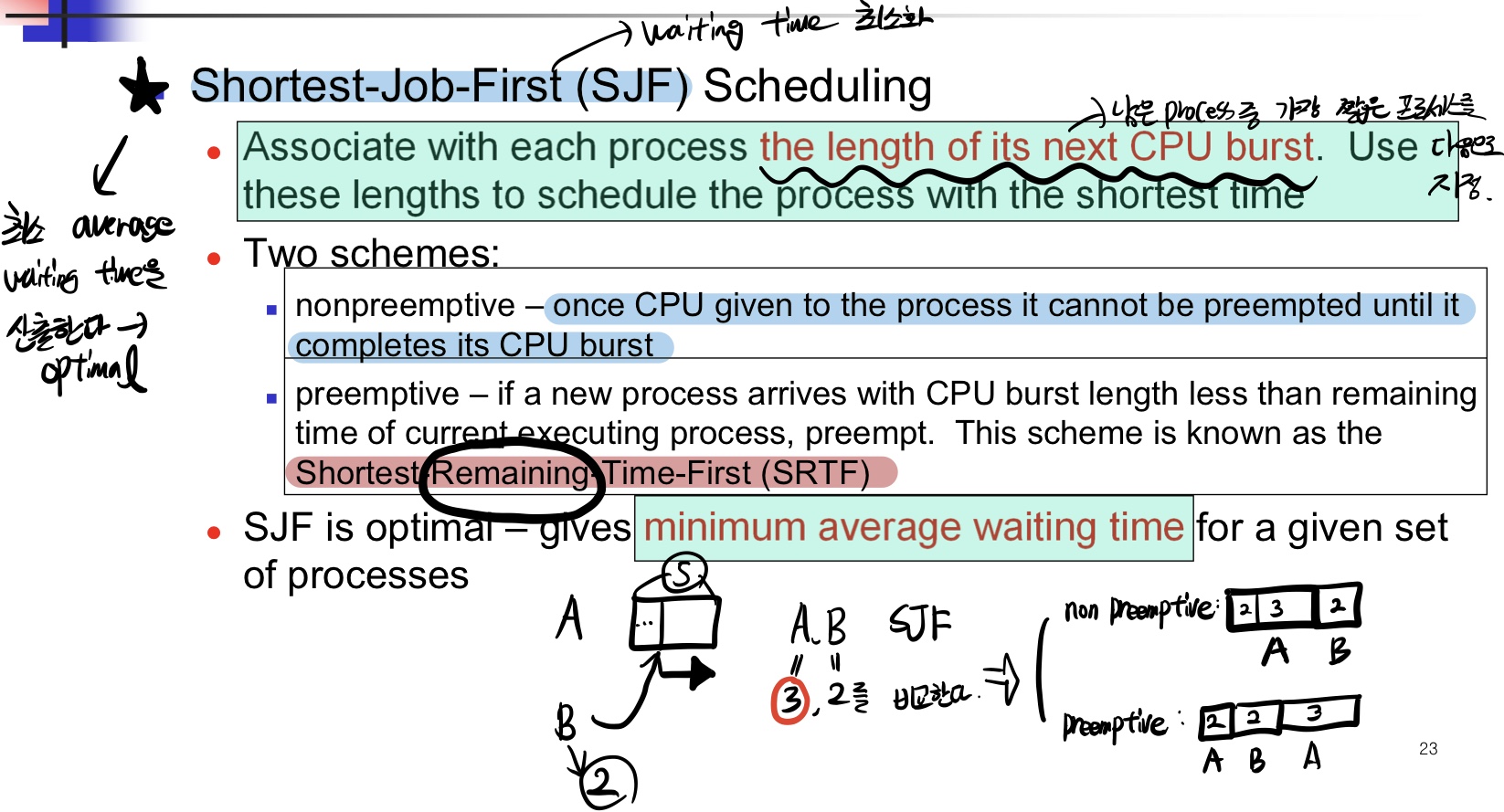
- 가장 Optimal(average wating time을 줄이는) 한 스케쥴링 알고리즘이다.
- 다음에 실행할 남은 프로세스 중 가장 짧은 프로세스를 결정하는 것이 필요하다.
why optimal?
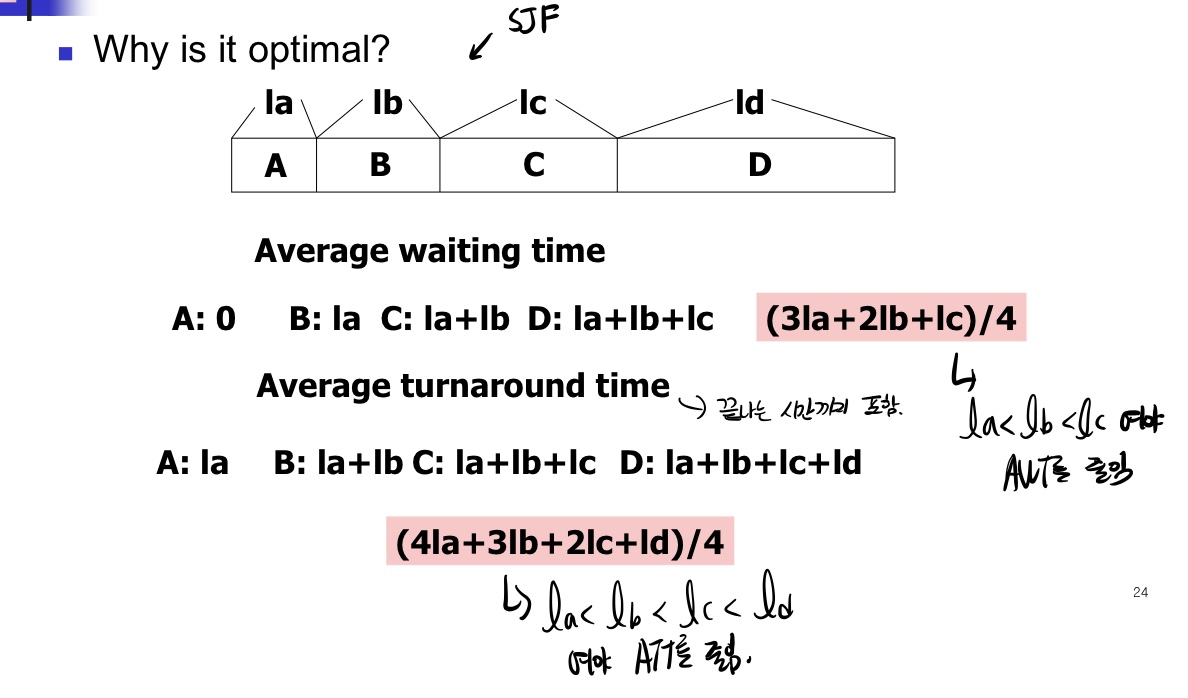
SJF(Non-preemptive)
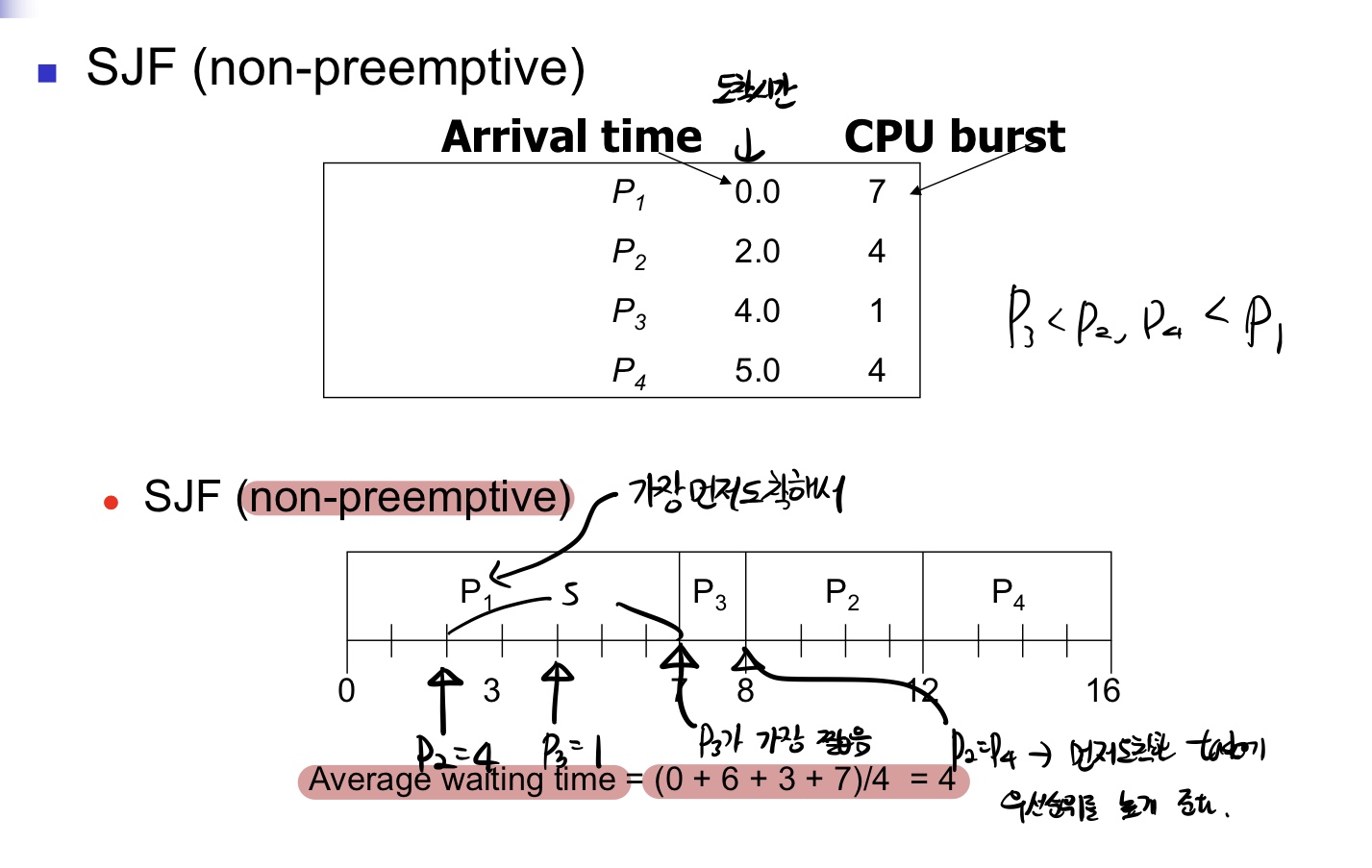
SJF(preemptive)
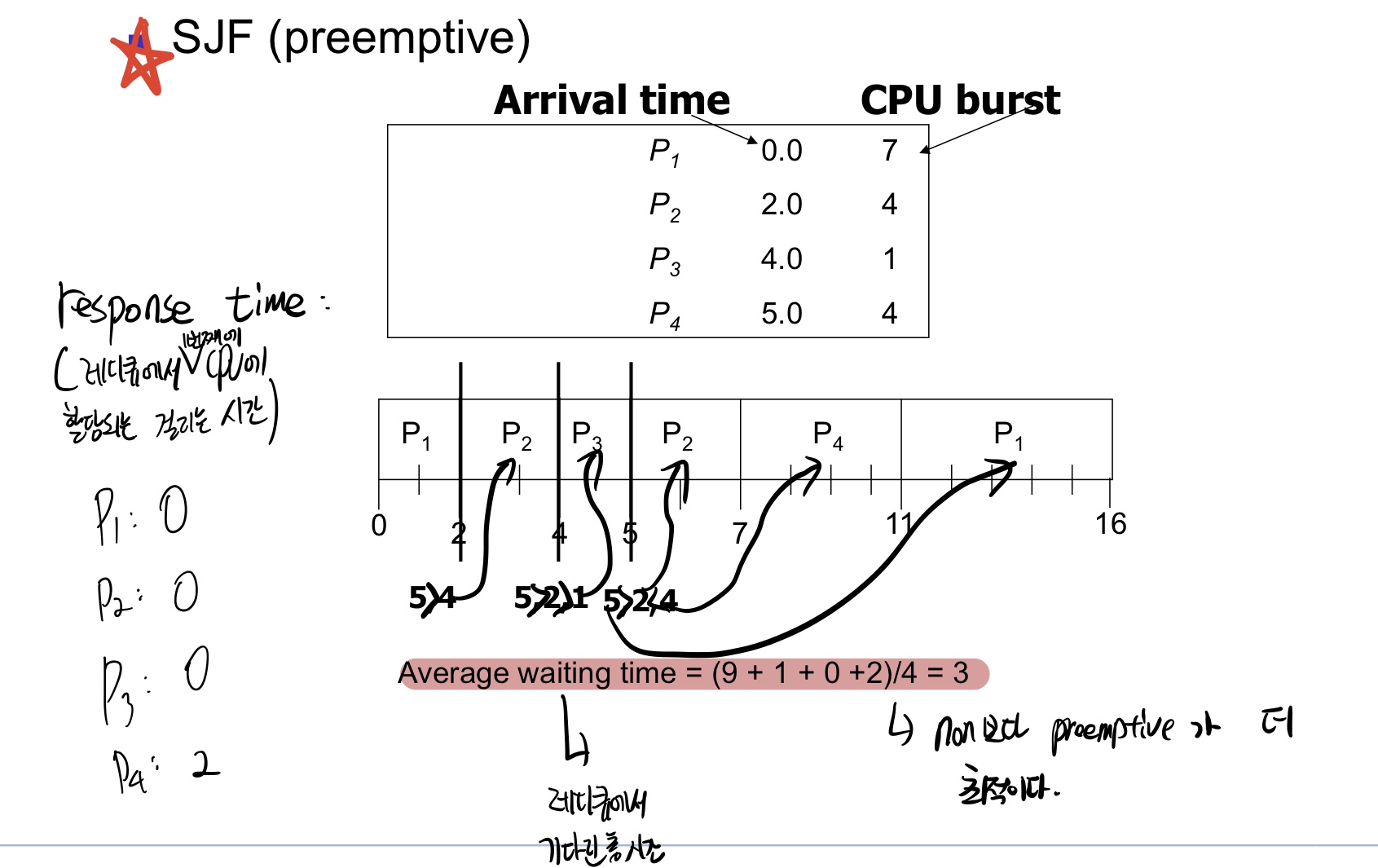
다음에 실행할 프로세스의 CPU Burst length를 구하는것은 실용적이지 않다.
- Next CPU Burst를 예측할수있어야한다.
- Exponential averaging을 사용한다.
- 두 가지 기준으로 예측한다.
- history cpu burst
- recent history
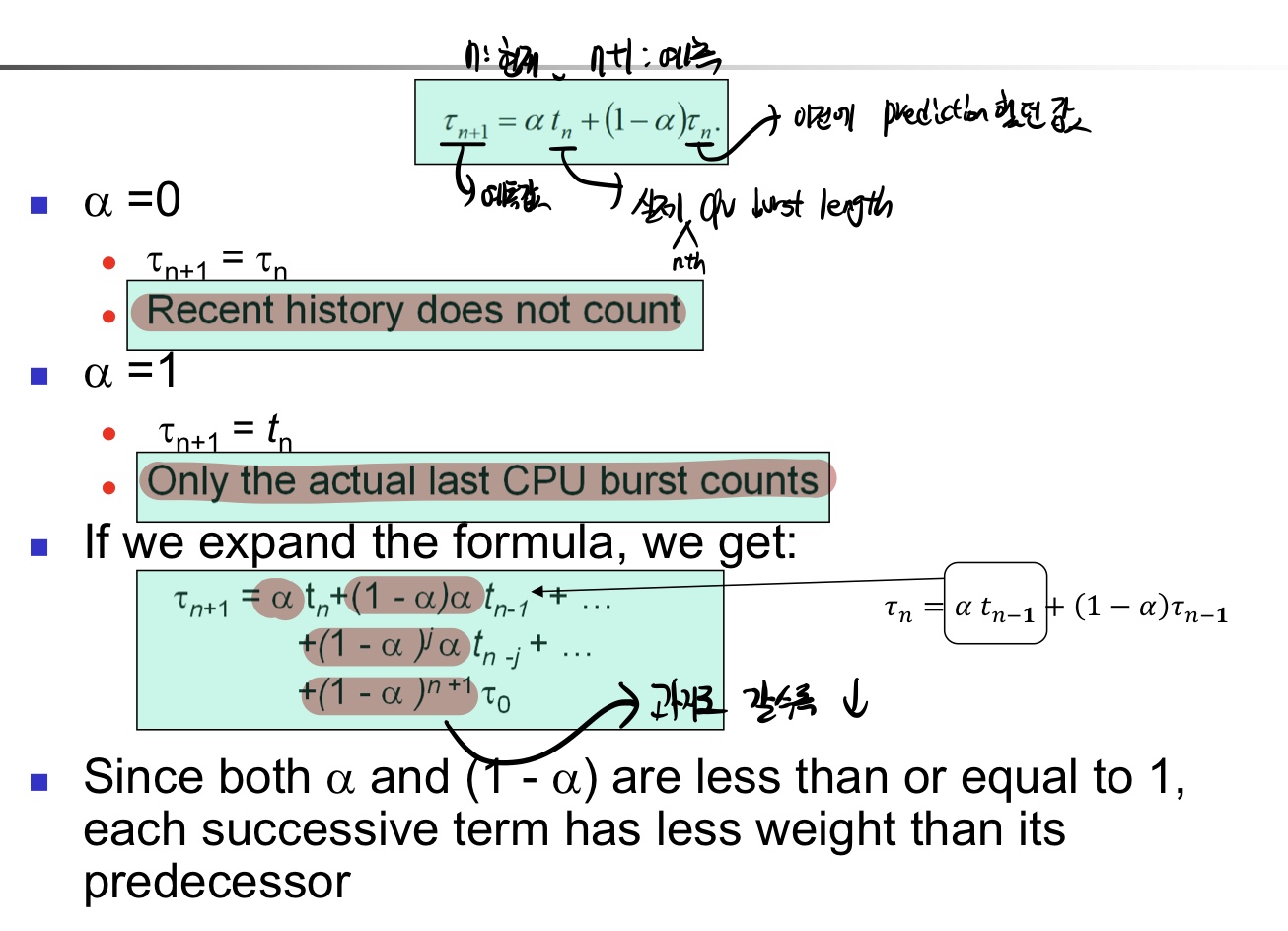

- 알파값은 자유롭게 줄수있다.
3. Priority Scheduling
- 낮은 priority number를 가질수록 높은 prioiry를 가진다.
- 문제점:
- Starvation(indefinite blocking)
- low priority processes may never execute
- solution:
- aging기법: 긴 시간 동안 레디큐에서 대기한 프로세스의 우선순위를 점차적으로 증가시키는것.
- Starvation(indefinite blocking)
- static priority: priority number is fixed
- dynamic priority: priority number can change
4. Round-robin Scheduling
- time quantum만큼 실행되고 번갈아가면서 스케쥴링하는 알고리즘
- Preemptive한 스케쥴링이다.
- time quantum이 크면 FIFO 구조가 된다.(fairness가 약해진다.)
- time quantum이 작으면 context switch가 빈번하게 발생해 overhead가 너무 크다.
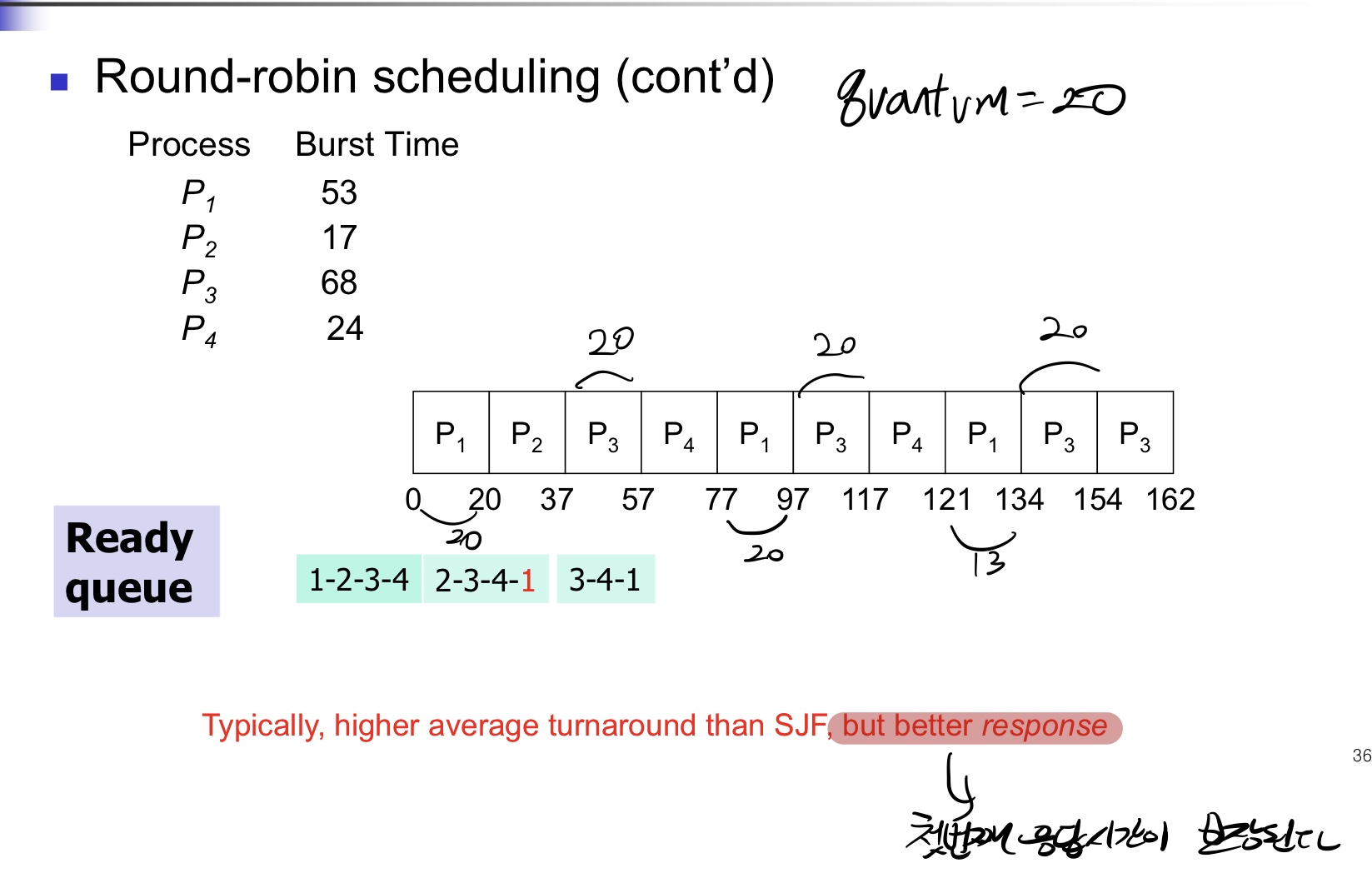
5. Multilevel Queue
- 총 세번의 스케쥴링이 필요하다
- 프로세스가 어떤 큐에 들어갈지
- 각 큐에서 어떤 프로세스를 선택할지
- 큐 간에 프로세스를 선택하는 것
- 큐 간에 스케쥴링은 두 가지 방법이 존재한다
- Fixed priority scheduling
- Time slice
Multilevel FeedBack Queue
- 큐간의 프로세스 이동을 허용한다.
5.Multiple-Processor Scheduling
-
CPU가 여러개 있을때 CPU 사이의 관계는 2가지가 있다.
- Symmetric: 모든 프로세스가 동일한 관계
- Asymmetric: CPU 사이에 master-slave 관계가 있다.
-
위 관계를 기반으로 CPU 스케쥴링은 두가지 방법이 있다.
1. Symmetric Multi-Scheduling- Asymmetric Multi-Scheduling
CPU Scheduling issue
- Process affinity:
- 프로세스가 실행될때 프로세스는 특정 프로세서에 affinity를 가지고 있다.
- affinity도 2가지로 나뉘는데
1. soft affinity: affinity를 해주려고 하나, 보장은 못해준다.
2. hard affinity: 무조건 affinity를 보장해주는것.(리눅스에서는 시스템콜을 명시적으로 호출하여 hard affinity를 보장해줄수있다.)
- Load Balancing
- push migration:
- 프로세서의 work-load를 체크해주는 별도의 프로세스가 있다.
- 그 프로세스가 할당된 프로세스가 많은 프로세서의 프로세스들을 널널한 프로세서들에게 push해준다.
- pull migration:
- 커널에서 널널한 프로세서엑 바쁜 CPU의 task를 pull 해서 가져옴.
- 커널에서 널널한 프로세서엑 바쁜 CPU의 task를 pull 해서 가져옴.
- push migration:
6.Thread Scheduling
- 각 클래스내에서 특정 알고리즘에 의해 스케쥴링(prioiry,cfs)이 발생하고,
- 큐 간에 스케쥴링(priority)이 일어난다.
- 각 프로세스들은 3개의 클래스로 나뉘어진다.
- Real-time FIFO classes: prioriy+FIFO 구조
- 우선순위가 동일한 프로세스가 큐에 있으면 먼저 들어온 프로세스를 먼저 스케쥴링한다.
- Real-time RR classes: prioriy+Roubd-robin 구조
- 우선순위가 동일한 프로세스가 큐에 있으면 각각의 process들은 time-quantum만큼 실행하고 큐의 마지막부분으로 간다.-> 번갈아가면서 스케쥴링된다.
- Conventional classes: CFS(Completely Fair Sharing) 방식
- 리눅스 2.6.23부터, CFS는 Conventional class들의 디폴트 스케쥴러 방식이 되었다.
-
특정시간에 1개의 process만 실행할수 있기 때문에 현실불가능한 방법이다.
-
대안으로,
- 위 방식을 사용한다. 어떤 시점에서 보더라도 proportion을 보장해준다.
- 리눅스는 CFS를 아래와 같이 실행한다.
- 가장 작은 vruntime을 가진 task를 선택한다.
- 즉 위의 방식으로 실행하면 어떤 시점에서 보더라도 proportion을 보장해준다.
7.Linux Scheduling
8.Algorithm Evaluation
1. Deterministic modeling:
특정한 프로세스와 프로세스의 burst time을 미리 정하고 gant chart를 이용해서 average waiting time, response time을 구하여 알고리즘을 평가한다.